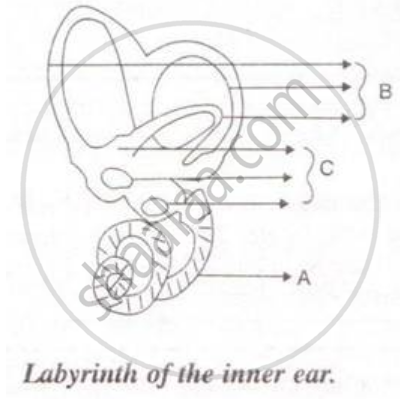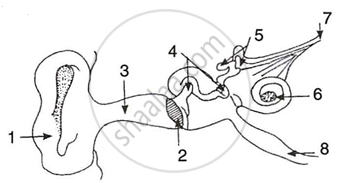Advertisements
Advertisements
प्रश्न
Draw a labelled diagram of the inner ear.
उत्तर
 |
APPEARS IN
संबंधित प्रश्न
Photoreceptor cells are present in __________.
(A) blind spot
(B) retina
(C) cochlea
(D) cornea
(i) Draw a well labelled diagram of the membranous labyrinth found in the inner ear.
(ii) Based on the diagram drawn above in (i) give a suitable term for each of the following descriptions :
1. The sensory cells that helps in hearing.
2. The part that is responsible for static balance of the body.
3. The membrane covered opening that connects the middle ear to the inner ear.
4. The fluid present in the middle chamber of cochlea.
5. The structure that maintains dynamic equilibrium of the body.
Give scientific reasons: We cannot distinguish colours in moonlight.
Give biological explanations for We should not put sharp objects into our ears.
The three parts of human ear contributing in hearing are-
Mention if the following statement is true (T) or false (F) Give reason.
The auditory nerve is purely for perceiving sound
Where is the oval window located? Briefly mention its function.
With reference to the human ear, answer the question that follow:
Name the nerve, which transmits messages from the ear to the brain.
What is the function of three tiny bones in the ear ?
Why should we not put a pin or pencil in our ears ?
Given below is a diagram of a part of the human ear. Study the same and answer the question that follow:

Name the parts labeled A, B and C in the diagram.
Differentiate between:
The middle ear and Inner ear.
The following diagram refers to the ear of a mammal.

(i) Label the parts 1 to 10 to which the guidelines point.
(ii) Which structure:
(a) converts sound waves into mechanical vibrations?
(b) Converts vibrations into nerve impulses?
(c) Responds to change in position?
(d) Transmits impulses to the brain?
(e) Equalizes atmospheric pressure and pressure in the ear.
The range of audible frequency for the human ear is
List the causes of noise pollution.
Categorise the following parts under (i) external, (ii) middle and (iii) internal ear.
Ear drum, hammer, pinna, cochlea, anvil, stirrup, eustachian tube, tympanum, oval window, semi-circular canals.
Which of the following structures equalises the air pressure on either side of the tympanum?
Note the relationship between the first two words and suggest the suitable word/words for the fourth place.
Eyes: Photoreceptors :: Ears : ______.
Give reason:
Three small bones of ear ossicles are advantageous as compared to one single bone for hearing.
The figure given below shows the principal parts of a human ear. Study the diagram and answer the following questions.
 |
- Label the parts 1 to 8.
- State the role of parts 6, 7 and 8.
- Why is it harmful to use a sharp object to remove ear wax? Mention the number and name of the part involved.
